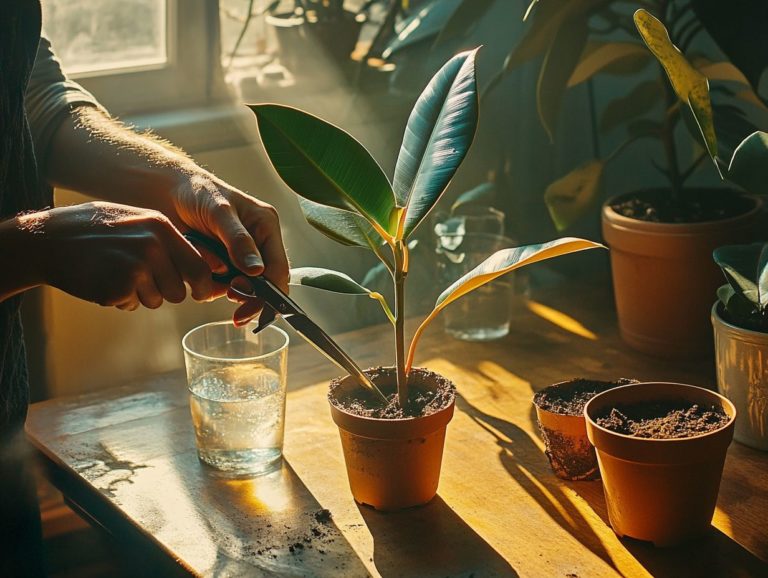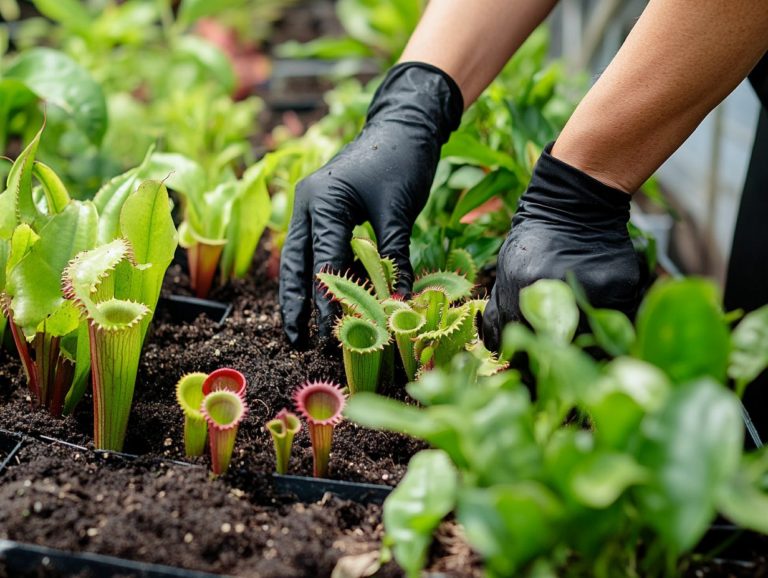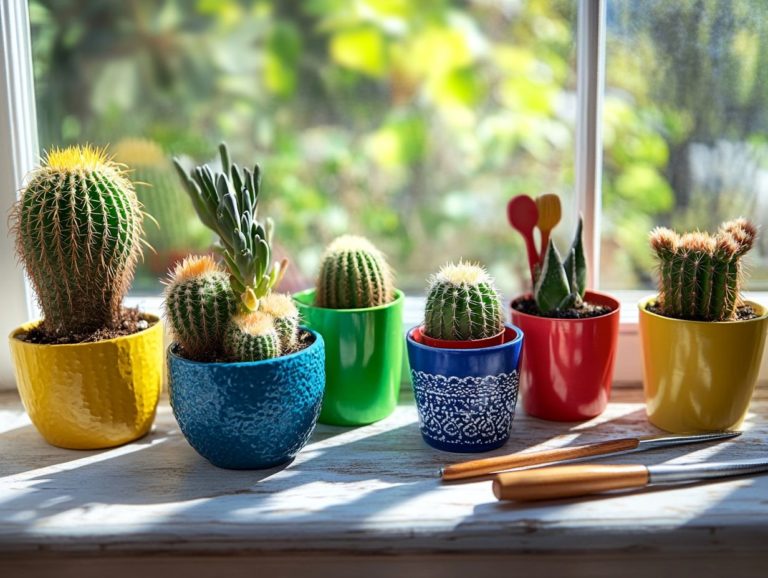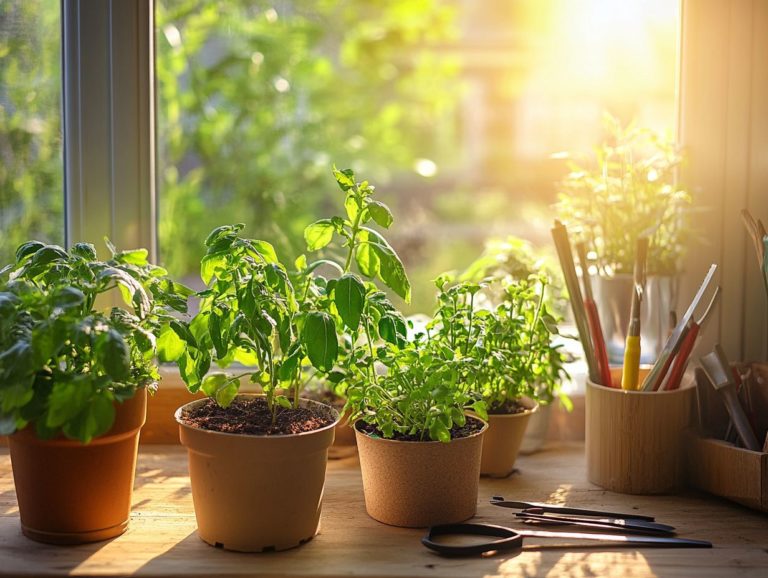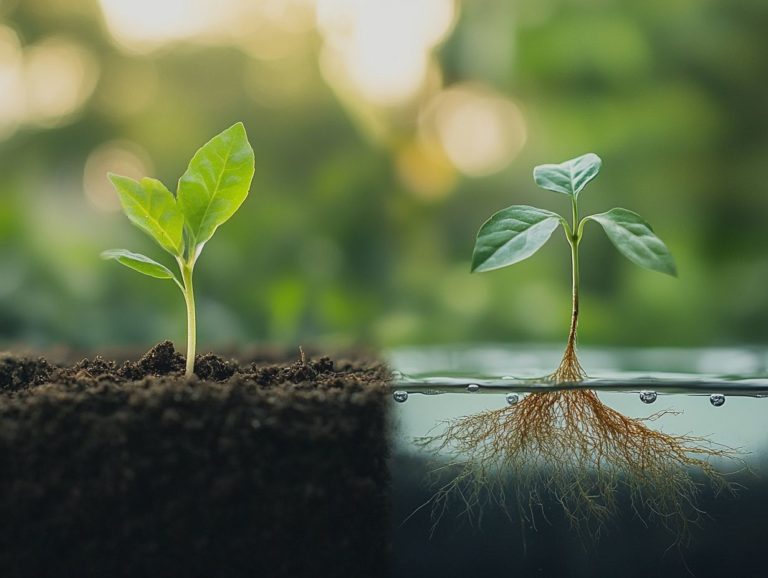How to Propagate African Violets
African violets are cherished houseplants, known for their vibrant blooms and lush leaves. If you re enchanted by their beauty, learning how to propagate them opens up exciting new possibilities.
Propagation helps you save money and lets you grow new plants from your existing treasures. Discover the joy of nurturing these delightful plants at home.
Contents
- Key Takeaways:
- Benefits of Propagating African Violets
- Methods of Propagating African Violets
- Supplies and Tools Needed for Propagation
- Step-by-Step Guide to Propagating African Violets
- Tips for Maintaining Healthy African Violets
- Common Problems and Troubleshooting
- Frequently Asked Questions
- How do I propagate African violets from leaves?
- Can I propagate African violets from stem cuttings?
- When is the best time to propagate African violets?
- Can I use water to propagate African violets?
- How long does it take for African violets to propagate?
- Can I use fertilizer when propagating African violets?
Key Takeaways:

- Propagating African violets is a cost-effective and enjoyable way to expand your plant collection.
- The main methods are leaf cutting, stem cutting, and sucker division, each having unique benefits and challenges.
- Essential supplies include well-draining potting mix, rooting hormone (a substance that helps roots grow), and a clean cutting tool.
What are African Violets?
African violets are the indoor plants you’ve dreamed of, famous for their vibrant colors and delicate flowers. These perennial beauties, also known as Saintpaulia, thrive in various conditions and bring joy to any home gardening enthusiast.
To care for them, grasp their light needs, ensure consistent moisture, and provide the right soil for healthy growth.
Originating from East Africa, these captivating plants have diverse leaf shapes and flower hues, from deep purples to soft pinks and whites. Popular varieties like Blue Belle showcase breathtaking violet-blue blooms, while Ninja features unique dark leaves with vibrant flowers.
The versatility of African violets makes them perfect for windowsills or terrariums. With regular indirect sunlight and appropriate humidity, they ll thrive, brightening your living spaces with a serene touch of nature.
Benefits of Propagating African Violets
Propagating African violets offers many benefits. You can broaden your plant variety without buying new specimens, clone plants to share with friends, or replace older plants.
This enjoyable process deepens your understanding of plant care and enhances your indoor gardening skills.
Why Propagate Instead of Buying?
Choosing to propagate African violets instead of purchasing new plants can lead to healthier growth and a sustainable approach to your gardening endeavors. Not only does propagation help you save money, but it also deepens your connection with your plants, allowing you to engage in their lifecycle from leaf cuttings to the breathtaking blooms. This method, which includes various propagation techniques such as water propagation and soil propagation, ensures you learn how to create robust plantlets that flourish in optimal conditions.
This practice encourages mindfulness and patience. You will witness the remarkable transformation of your efforts into stunning foliage and vibrant flowers.
By propagating, you cultivate a diverse array of plants tailored to your specific environment. This enhances biodiversity and reduces reliance on commercial growers.
As you master techniques like leaf and stem cuttings, you develop valuable skills that contribute to improved plant health and resilience against pests and diseases.
Ultimately, embracing propagation not only enriches your gardening experience but also supports a more eco-friendly lifestyle.
Methods of Propagating African Violets
Discover various exciting methods for propagating African violets, each with unique benefits waiting for you to explore! The two most popular methods are leaf cuttings and stem cuttings, along with sucker division, which can be carried out through either water propagation or soil propagation.
Master these techniques to choose the best approach for your resources and goals, ensuring your gardening journey is both rewarding and successful.
Leaf Cutting
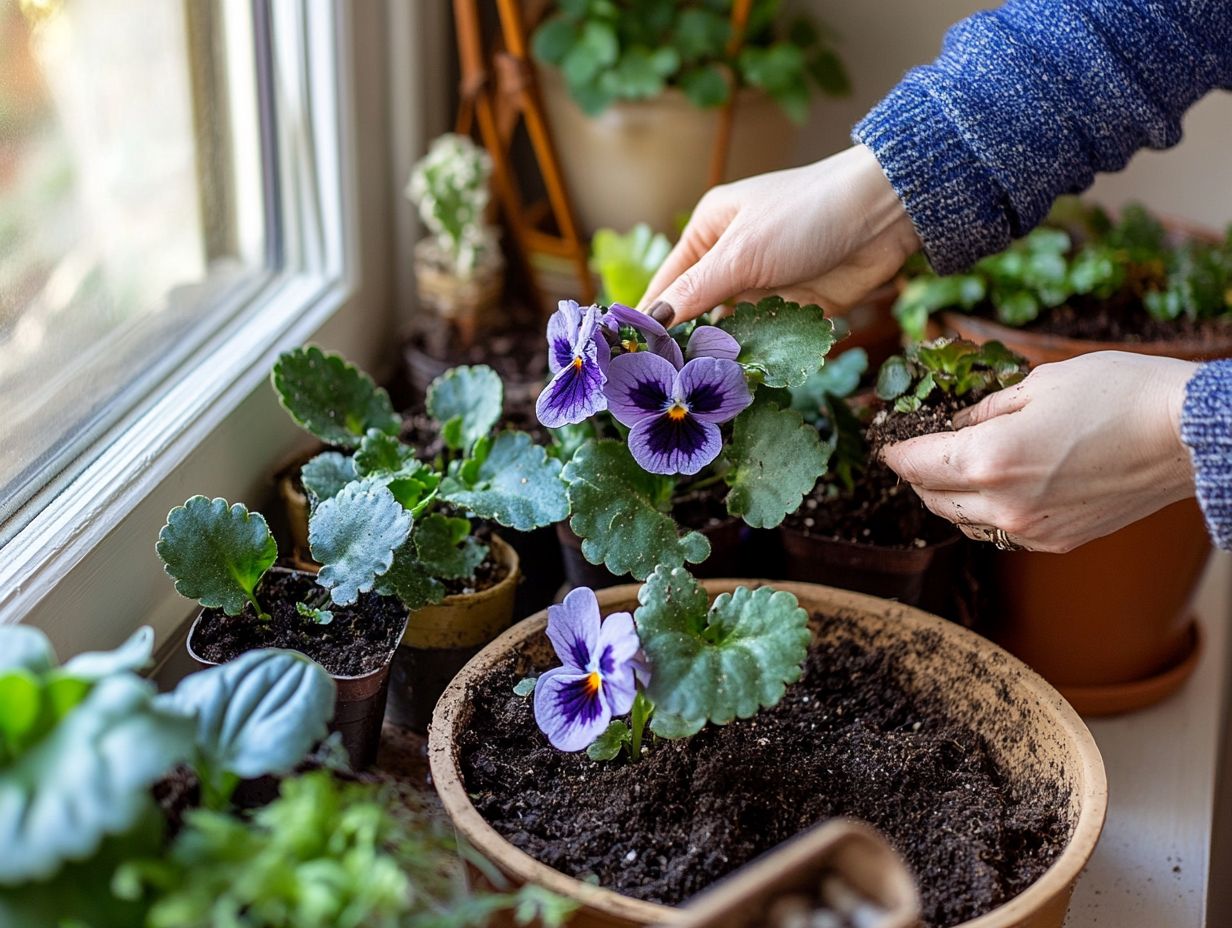
Leaf cutting is a favored technique for propagating African violets, where you can take healthy leaf cuttings to generate new plants. By using a rooting hormone, a substance that promotes root growth, and providing proper care, those cuttings can flourish into vibrant flowers. This method shines for its simplicity and effectiveness, making it the perfect choice for both beginners and seasoned gardeners time to dive in!
To successfully employ the leaf cutting technique, begin by selecting a mature, disease-free leaf from a healthy African violet plant. Next, cut the leaf into sections, ensuring each piece contains a vein or two, as these will boost rooting. For those interested in expanding their plant care, learning how to propagate succulents successfully can also be beneficial. Dip the cut ends into rooting hormone to expedite root development.
Place the cuttings in a mix that drains well, positioning them at an angle to facilitate moisture retention. It s vital to keep the soil consistently moist just shy of soggy so consider using a humidity dome or plastic bag to help maintain moisture levels. Place the cuttings in bright, indirect light. Avoid direct sunlight to prevent leaf scorch. Regularly check the moisture and make adjustments as needed to create optimal conditions for successful propagation.
Stem Cutting
Stem cutting is an excellent way to grow new plants for African violets that you can easily master. By cutting a healthy leaf stem, you encourage root growth in suitable potting soil. This paves the way for new plants that will thrive in their specific soil conditions.
This technique not only enhances your gardening skills but also enriches the diversity of your indoor garden. When selecting stems, be sure to pick mature, disease-free leaves that are firm and vibrant; this significantly boosts your chances of successful rooting.
Cut the stem at a 45-degree angle to maximize surface area. Don t forget to remove any lower leaves to reduce the risk of rot when planting.
Once your cuttings are prepared, ensure that your potting mix is soil that drains well but still keeps some moisture, creating an ideal environment for growth. Place them in a warm, bright location just keep them out of direct sunlight and maintain consistent moisture levels.
With the right attention and care, your cuttings will develop strong roots and flourish into healthy, vibrant African violets over time.
Sucker Division
Sucker division is a less common yet highly effective method for propagating African violets. By removing suckers or offshoots from the parent plant, you can encourage new growth while promoting the overall health of your plants.
This technique alleviates crowding and gives you the power to cultivate multiple vibrant specimens, enhancing your gardening skills and deepening your knowledge of plant maintenance. To master sucker division, begin by carefully identifying the suckers those small shoots that develop at the base of the plant.
Armed with clean, sharp scissors or pruning shears, snip these offshoots away, making sure to leave a small portion of the root intact. This technique improves airflow around the parent plant and minimizes competition for nutrients, resulting in stronger, healthier blooms.
As you nurture the newly separated suckers, it s crucial to provide them with the right humidity, light, and a suitable potting mix. Regular watering and an occasional dose of fertilizer will encourage robust growth.
Supplies and Tools Needed for Propagation
Equipping yourself with the right supplies and tools is vital for successfully propagating African violets. Essential items include good potting soil that helps plants grow, perlite, and vermiculite, all of which support robust root growth.
Having sharp scissors, rooting hormone (a substance that helps plants grow roots), and suitable containers will improve your propagation efforts.
Essential Items for Successful Propagation
To successfully propagate African violets, you’ll need a few essential items for houseplants. Rooting hormone is crucial for encouraging root growth. Additionally, choose containers that retain consistent moisture for growing conditions.
Using a well-draining soil mix with perlite or vermiculite provides the nutrients your violets need while helping to prevent root rot. A humid environment enhances growth, which you can achieve by using a humidity dome or simply placing a tray of water nearby. If you’re interested in expanding your indoor garden, learning how to propagate spider plants can be a great addition to your plant care routine.
Timing is key; aim for propagation during the warm months for the best results with your cuttings. Maintaining adequate light requirements without the harshness of direct sunlight will ensure that your new plantlets develop robust foliage.
By combining these practices, you’ll promote healthy growth and create the ideal environment for growing plants for your African violets to thrive. Imagine watching your African violets thrive using these simple propagation techniques!
Step-by-Step Guide to Propagating African Violets
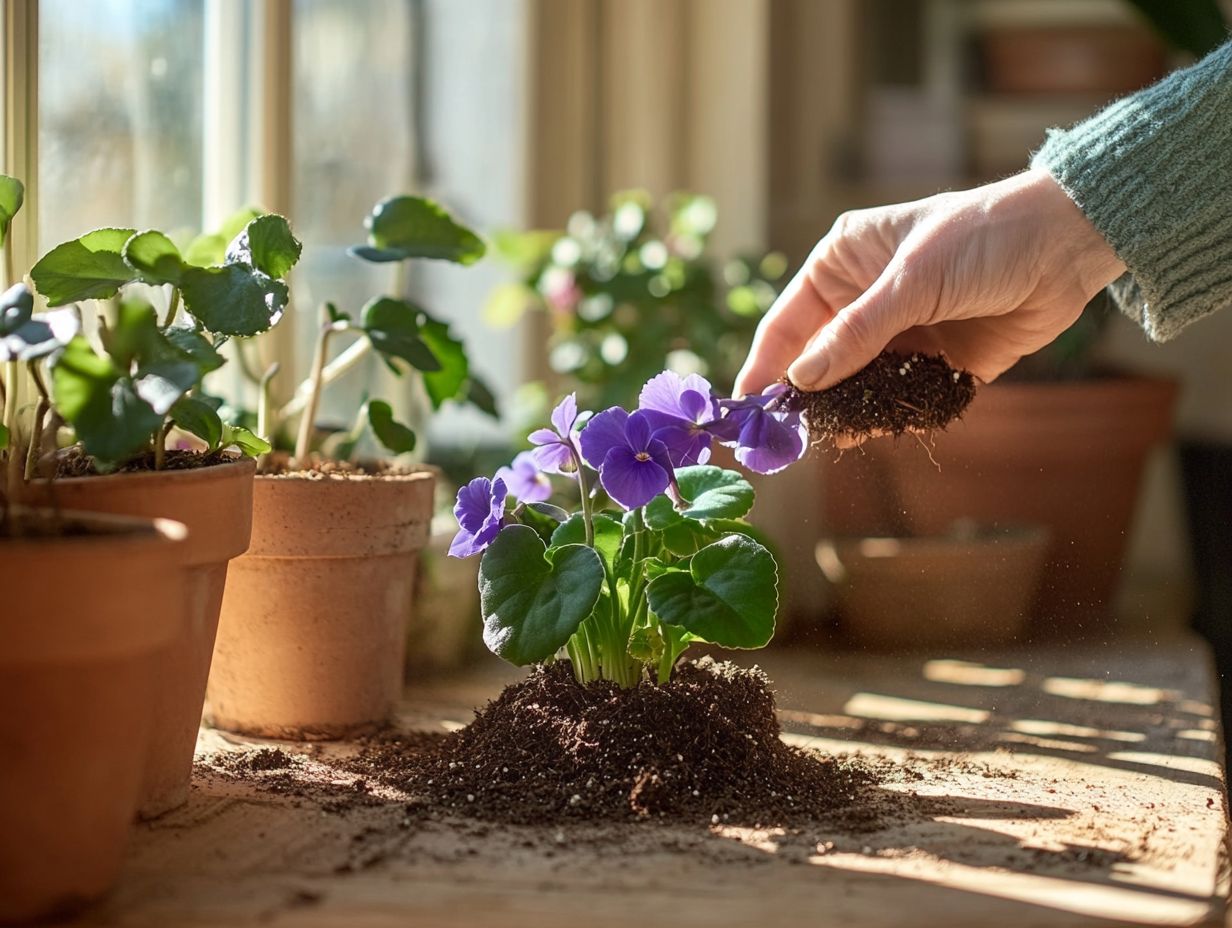
This step-by-step guide to propagating African violets empowers you with the expertise needed to clone plants through leaf cuttings or alternative methods. This will ensure their health and vibrancy.
By carefully following each propagation step, you can enjoy the process and nurture new plants that thrive in indoor settings for vibrant colors. This approach will enhance your appreciation for gardening and plant care and improve your skills in plant maintenance.
Detailed Instructions for Each Method
This section offers comprehensive instructions for each propagation method, including water propagation and soil propagation. Understanding these techniques is crucial for the overall health of your plants.
By exploring various methods, you can choose the best approach for your environment and available resources. Water propagation is popular as it allows easy observation of root development. Soil propagation offers a more traditional route, leading to faster nutrient absorption.
Consider factors like humidity, temperature, and light exposure, as these conditions can significantly impact your success. Use clean, sharp tools during propagation to minimize the risk of disease and protect the health of your new plants.
With patience and attention to detail, you can embrace the rewarding practice of propagating African violets.
Tips for Maintaining Healthy African Violets
Maintaining healthy African violets requires focused care, where your attention to detail can enhance their growth and flowering. Ensure they receive adequate light, follow a consistent watering schedule, and pay close attention to soil conditions.
By following these guidelines, you can enjoy the vibrant beauty of your African violets for years to come.
Proper Care and Maintenance
Caring for African violets requires a balanced approach to watering, soil conditions, and plant care techniques for optimal growth.
Establishing a consistent watering schedule is crucial. These plants thrive on regular moisture but are sensitive to overwatering, which means giving them too much water can harm their health. Understanding their light requirements also plays a significant role in their ability to bloom. They flourish best in bright, indirect sunlight, so placing them near a window with filtered light is wise.
Use a well-draining soil mix enriched with organic matter to promote healthy root development and avoid water retention issues. Regularly check for pests that affect plant health and provide gentle fertilization to enhance growth, which can further improve their vibrancy. By attending to these factors, you can cultivate stunning blooms and lush foliage that truly captivate.
Common Problems and Troubleshooting
Understanding common problems and troubleshooting methods for African violets is essential for maintaining plant health. Challenges like wilting, yellowing leaves, or pest infestations can detract from the beauty of these beloved blooms.
However, with the right skills, you can manage many of these issues. By honing your ability to identify and address concerns, you ll enhance your gardening experience and cultivate a thriving environment.
Identifying and Addressing Issues

Keep an eye out for signs that your African violets are not healthy. Take quick action to fix any problems you notice.
Common challenges include root rot, a condition where roots decay due to excess moisture; fungal infections that affect plants; or pest infestations. Prompt intervention is essential to prevent further damage. By staying vigilant and managing these challenges, you can protect your plants and create a thriving environment!
One effective strategy is to regularly inspect the leaves for any discoloration, wilting, or unusual spots. These symptoms often signal distress.
Checking the soil moisture is essential. African violets flourish in well-draining soil, and overly wet conditions can lead to root rot.
For pest management, consider using natural solutions like neem oil or insecticidal soap. They can effectively tackle common nuisances such as aphids and spider mites. Good air circulation around your plants helps prevent fungal outbreaks and promotes overall health.
Watch this video for a visual guide on propagating African violets!
Frequently Asked Questions
How do I propagate African violets from leaves?
- Choose a healthy leaf from a mature African violet plant.
- Cut the stem of the leaf at an angle, about 1 inch from the base of the leaf.
- Place the stem in a glass of water or moist potting mix.
- Keep the stem in a warm and bright location, but not in direct sunlight.
- In a few weeks, roots will start to grow from the stem, and a new plantlet will form.
- Once the plantlet has grown a few leaves, it can be transplanted into its own pot with potting soil.
Can I propagate African violets from stem cuttings?
- Yes! Take a healthy stem cutting from a mature African violet plant.
- Remove the bottom leaves from the cutting.
- Dip the cut end of the stem in rooting hormone.
- Place the stem in a pot filled with moist potting mix.
- Cover the pot with a plastic bag to create a greenhouse effect.
- Keep the cutting in a warm and bright location.
- After a few weeks, roots will start to grow, and a new plant will form.
- Once the new plant has grown a few leaves, it can be transplanted into its own pot.
When is the best time to propagate African violets?
The best time to propagate African violets is during their active growing season, which is typically from spring to summer. This is when the plant is in its most active state and has the highest chance of successful propagation. However, with proper care and attention, African violets can be propagated at any time of the year.
Can I use water to propagate African violets?
Yes! You can use water to propagate African violets. This method is called water propagation. Follow these steps:
- Take a healthy leaf or stem cutting from a mature African violet plant.
- Place the cutting in a glass of water, making sure the bottom of the stem is submerged.
- Change the water every few days to prevent bacteria from forming.
- Once roots have grown about an inch, the cutting can be planted in potting soil.
- Continue to care for the new plant as you would a mature African violet.
How long does it take for African violets to propagate?
The time it takes for African violets to propagate can vary depending on the method used. Leaf propagation can take about 6-8 weeks, while stem propagation can take about 4-6 weeks. Water propagation may take slightly longer, around 8-10 weeks. However, these are just estimates and can vary based on conditions and care given to the plant.
Can I use fertilizer when propagating African violets?
It is not recommended to use fertilizer when propagating African violets. These plants are sensitive to changes, and too much fertilizer can harm the new plant. Wait until the new plant has grown a few leaves before introducing fertilizer into its care routine.

